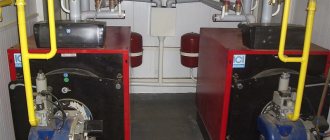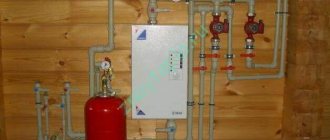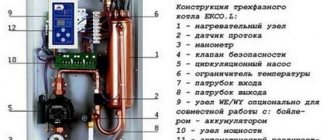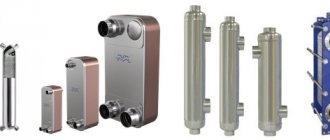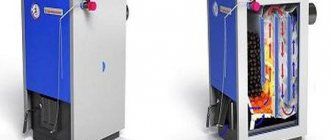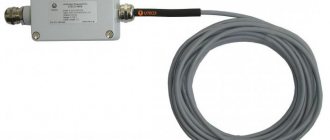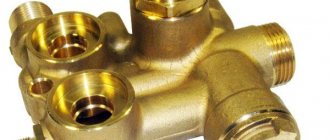Industrial and production complexes need high-quality and inexpensive heat supply devices that would demonstrate efficiency at relatively low costs. A gas boiler house copes with these tasks better than alternative solutions, which is why in most cases the heating system at Russian enterprises is implemented precisely on its basis. Moreover, this technology has shown itself to be equally justified both for servicing administrative buildings and industrial, production or auxiliary workshops.
Scope of use of gas boiler equipment

It forms an important part of the engineering design of residential, industrial, agricultural, public, and construction projects. Catering establishments, sauna and bath complexes, laundries, dry cleaners - the group of users includes companies of almost any profile. In the agricultural sector, a gas boiler room is used for drying grain, heating greenhouses, and heating livestock farms.
boiler equipment has found wide application in a wide variety of processes:
- technical and technological;
- hot water supply;
- heating;
- ventilation.
Among all types of equipment for a gas boiler house (solid, liquid fuel and gas), gas systems are most widespread. Against the backdrop of the dynamic development of the coldest regions of northern and eastern Russia, the demand for them is constantly growing. And the efficiency of gas in terms of thermal energy production is fully justified by the efficiency of modern heating equipment for the boiler room and the low costs of their operation.
Distribution manifold
The distribution manifold is equipment in the boiler room of a house that controls the processes in each individual heating circuit. This part of the system is perfectly suited for underfloor heating systems and various types of radiators. This system, intricate at first glance, is designed by its existence to establish a proportional distribution of heat flows from the boiler to heat consumers. Thanks to the existence of this system, the temperature in each individual part of the living space is easily regulated.
The appearance of this boiler room equipment in a house can be described as follows - it is a metal comb with a number of leads to which coolant is supplied from the boiler and which distributes the coolant throughout all heating circuits. Externally, they differ little, but there is a significant difference in the materials used and the complexity of the design. Most often they are made of steel, copper, brass and polymers. Simple combs are limited in the operating capabilities of the device, while advanced analogues are modified with a variety of sensors, control units, as well as electronic valves and air release devices.
Installing a collector system guarantees the most reasonable heat distribution in the house, but it should be borne in mind that this system is useless without the use of circulation pumps, and the technology itself has a fairly high price.
Design

Structurally, a boiler room is a functional structure designed to bring the temperature of the coolant to a given level for the purpose of heating, supplying hot water or supplying steam. All equipment for a gas boiler room is located in one technical room. Water is usually used as a coolant. Depending on the scale and operating conditions, the set of equipment for a gas boiler room may differ, but the basic elements are always:
- boilers (steam, hot water, fire tube);
- equipment connection elements for boiler installation;
- gas pipeline;
- fittings
Circulation pump

Many heating systems use the principle of natural coolant circulation, but there is a more advanced option for fluid movement. It is achieved by installing circulation pumps in the pipes, as well as the necessary boiler room equipment in the house, as a result of which the efficiency of the entire heating system increases. This occurs due to an increase in the coolant velocity. Due to the accelerating movement of the coolant, heating and heat transfer occur as quickly as possible, as a result of which it becomes possible to reduce the diameter of the pipes and reduce the load on the boiler.
The structure of the pump is very simple; it most often consists of a cast iron body, inside of which a rotor rotates with an impeller attached to it. The most interesting thing is that, despite the amount of fluid being pushed, a quality rotor makes almost no noise when installed correctly. One of the main installation principles is the strictly horizontal position of the rotor. It is recommended to pay attention to products made in Germany and Italy, as they are considered to be of the highest quality and relatively inexpensive.
Purpose of equipment for a gas boiler installation

Depending on the level and nature of consumption of gas boiler products, domestic or industrial systems can be used. The former are used to supply heat to small objects - residential apartments, offices or shops. The latter are used both by individual industrial complexes and by utility service providers that provide heat supply to entire neighborhoods or residential villages.
Boiler room equipment is represented by a number of devices and fixtures, structures, and elements. This includes:
- boilers of different power;
- burners;
- heat exchangers;
- chimneys;
- ready-made block modules, etc.
The operating principle is based on 2 phases of heat exchange. In the first phase, the boiler carries out primary exchange, transferring the energy of the combustion gas to the carrier. The coolant - water, non-freezing liquid, steam - passing along the pipeline route, transports the energy converted into heat to the consumer. In the second phase, the carrier releases the received energy, bringing the air temperature in the serviced premises to the required (optimal for a person).
Expansion tank
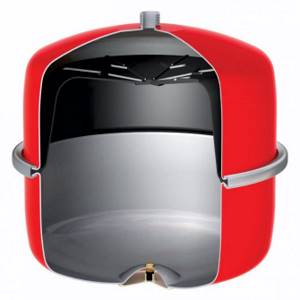
Also important equipment for the boiler room in the house. The boiler system is filled with a coolant substance, most often it is, of course, water, but when the system heats up, there may be a tendency for excess pressure to form against the background of thermal expansion of the liquid. To avoid breakdowns and any violations in the integrity of the heating system, an expansion tank is used.
There are two types of tanks for equipping a boiler room in a house. The first is open, at the moment it has almost ceased to be used, technically it compensates for changes in the volume of the coolant, opening the outlet to the atmosphere, but this technology is extremely crude, it requires constant monitoring and topping up of liquid, it is difficult to install and is often prone to corrosion.
Open tanks (or membranes) soon replaced open tanks. Most often they have a sealed cylindrical shape made of steel. The internal volume of these tanks is occupied by a membrane that separates inert gas or excess air from excess coolant coming from the boiler system during its expansion. Under the pressure of the liquid, the air is compressed, but as soon as the temperature (and, consequently, the pressure) drops, the gas regains its original volume and, with the help of a membrane, pushes the coolant back into the system for its further circulation.
Equipment for liquefied gas boiler room

Along with a gas boiler plant running on natural gas, a boiler plant operating with LPG has found widespread use in industry. Their popularity is explained by a number of advantages:
- autonomous operation (like a natural gas system, it is equipped with a full set of equipment - valves, shut-off valves, pumps, automation, etc.);
- no dependence on pressure in the media supply system;
- the ability to normalize and limit the operation of the system;
- no risk of increasing the cost of heat supply;
- reliability.
The key feature of such an engineering solution is the cost of additional equipment for the boiler room , namely a special storage tank for fuel. It is called a gas holder and has different volumes (from 5 to 50 cubic meters). Gas tanks are connected to the heating system using a separate pipeline - a gas duct. Through it, LPG enters the boilers.
The tank is refilled at a specified frequency. The latter depends on the initial volume of the container and must be strictly controlled by the user manual. Only a licensed performer can upload. A license of this type allows you not only to perform turnkey refueling, but also to carry out other important manipulations for servicing boiler equipment :
- carry out a technical inspection of the gas tank itself;
- carry out diagnostics of the state of the gas duct.
Hydroarrow
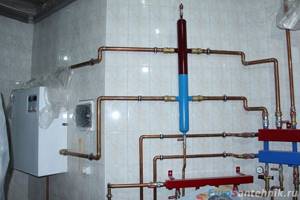
The hydraulic arrow, as a representative of the boiler room equipment in the house, has a number of other names; it can be called a hydraulic separator, a hydrodynamic thermal separator, or a “bottle”. This device has a fairly simple shape - it is a cylindrical or rectangular vertical structure with nozzles located opposite each other: two on each side (however, there may be more). Its functionality is to separate the temperature and coolant flows within the coolant outlet and inlet into the boiler; thanks to its operation, efficiency increases significantly, but only if it is suitable for your heating system, which most often requires accurate and error-free calculations. It is important to take into account that for the hydraulic arrow to function, the presence of a circulation pump in the system is indispensable; it must be attached to each circuit.
Operation of boiler room equipment

The operation of equipment for a gas boiler room requires compliance with a number of rules aimed at the safe and efficient use of the system. The operating rules require high-quality preparation of all elements of the boiler installation for the cold season. What does this preparation include:
- ventilate the premises for at least 10–15 minutes;
- removing the plug from the first valve;
- opening the first valve at the coolant inlet by approximately 25%;
- raising the safety valve plate (it needs to be lifted slightly by engaging the valve levers);
- opening valves and taps along the gas route.
Before starting work at the site, you need to organize lighting (auxiliary, in a safe mode). Ideally, they should be carried out by a specialist with the appropriate license: being well acquainted with all the risks and features of the process, he minimizes the likelihood of force majeure or failures, delays in the startup of boiler installation equipment.
Buy equipment for boiler installation

Reliability, cost of operation and durability of equipment directly depend on the quality of its performance. In the catalog of LLC NPO "SpetsNefteMash" you can select and order equipment for a boiler room , which will justify its price not only in efficiency and reliability, but also in safe operation, thoughtful design, high quality workmanship of each element and optimal completeness.
We are engaged in the production and installation of equipment for boiler houses , therefore we offer our products without extra charges, but with a factory guarantee. Plus, qualified advice on the selection of components and fast delivery to any region of the Russian Federation or neighboring countries. Contact us using any of the methods listed in the contacts section, and we will select the optimal technical and design heating solution for your facility.
Pipes
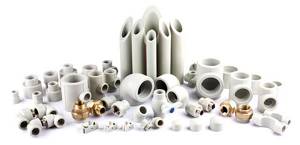
You should pay close attention to even such seemingly trifle equipment of the boiler room in the house. It is logical that metal pipes are very popular. The most common materials used for them are steel and copper. Steel pipes withstand high temperatures well, withstand high pressure, have a low price, but, unfortunately, are very prone to corrosion. Copper pipes are not prone to rust and are considered the best option for home heating, but they are quite expensive.
The equivalent of copper pipes is polypropylene pipes. They are not prone to rust, are extremely resistant to high temperatures and aggressive substances, and have a large margin of safety, also due to their smooth structure. They are cheaper than copper ones, which is why they are currently enjoying the greatest (and it should be noted, well-deserved) popularity.
Metal-plastic pipes are also known; in fact, they are nothing more than pipes made of the same polypropylene reinforced with some metal; they literally combine the best possible properties of the materials described above. Moreover, they are able to change their shape and bend in any way necessary.
